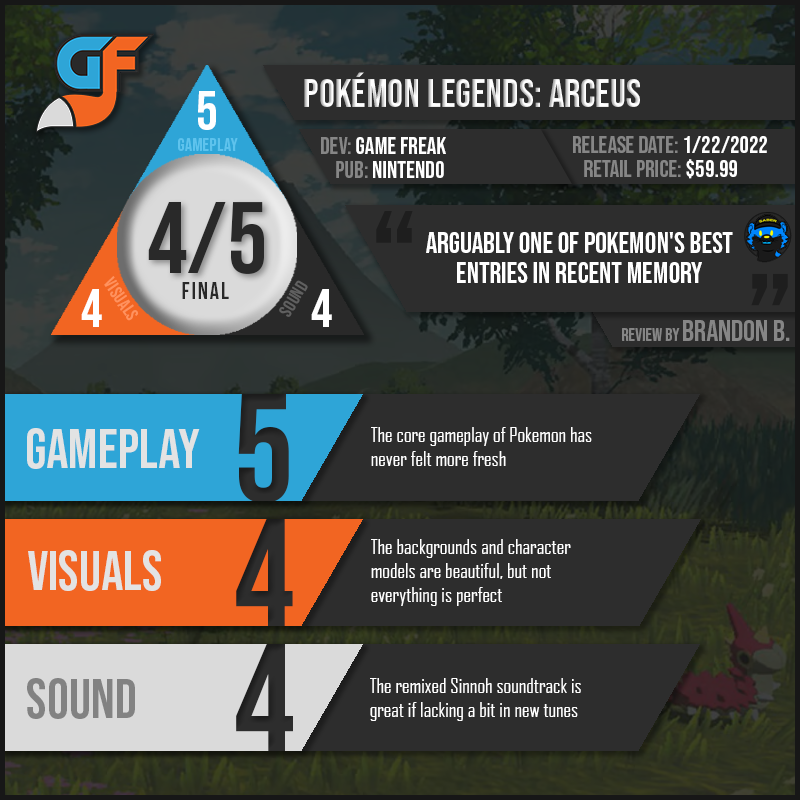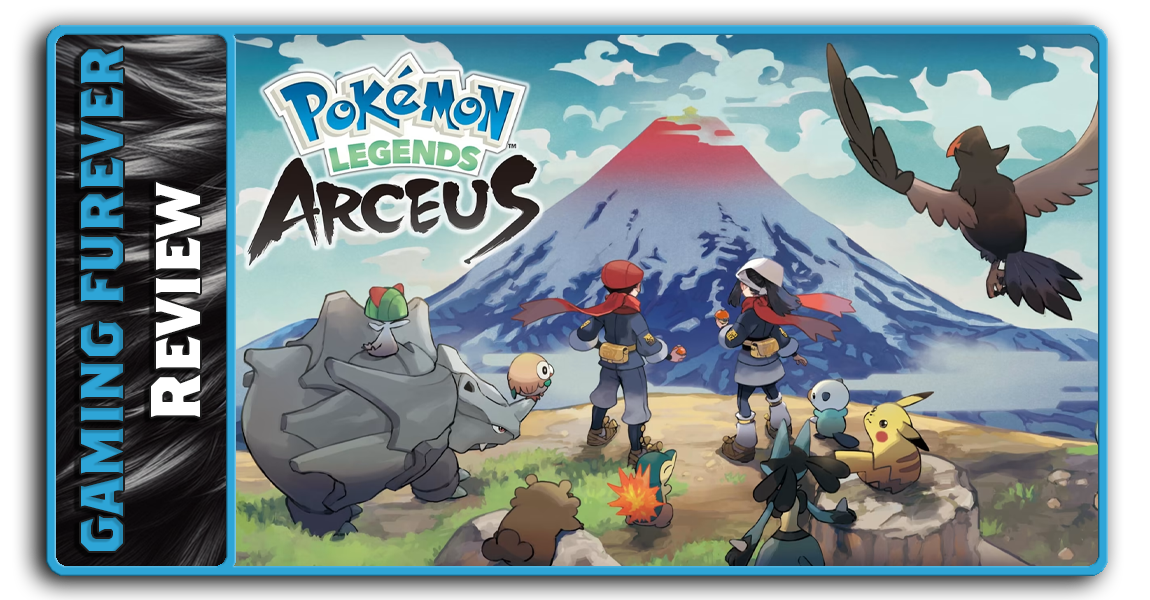I’ve mentioned the upcoming Legends Z-A a few times now. But before we venture into the bright lights and busy streets of Luminose City, I thought it would be good to take a look back, in more ways than one.
Pokémon Legends: Arceus released on January 28, 2022 and marked the end of what fans call the 8th generation of Pokémon. At this point, Pokémon on the Switch had been an interesting journey. Let’s Go experimented with combining Pokémon Go’s capture mechanics with a more standard Pokémon experience and saw success. Pokémon Sword and Shield released to both acclaim and controversy while being the first games to feature paid DLC. Just over 2 months before Legends, Brilliant Diamond and Shining Pearl, two remakes not directly developed by Game Freak, also released and took us back to Sinnoh. Scarlet & Violet, the start of the 9th generation of Pokémon, were also right around the corner being released in November of 2022. It was a busy time but Legends: Arceus proved to be a welcome breath of fresh air that fans both new and old could enjoy.
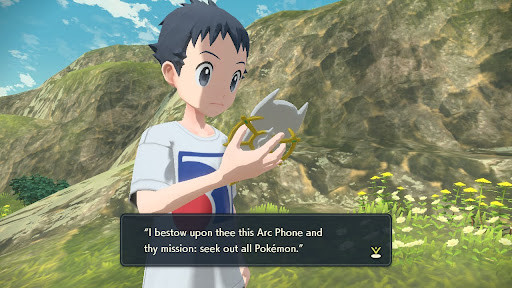
The premise of Legends: Arceus is fairly straightforward at first. The player is sent to the land of Hisui in the distant past by Arceus itself with one task: Meet and catch every Pokémon. Soon after arriving, you meet the cheerful Professor Laventon, who observed you falling out of the sky. He introduces the games three starter Pokémon: Rowlet, Cyndaquil and Oshawott before they run off and he has to ask the player to catch them. After doing so and impressing the professor, you’re brought to Jubilife Village and invited to join the Galaxy Teams Survey Corps. It’s after passing another test and officially joining that the game opens up and you find yourself investigating strange phenomena relating to the local guardian Pokemon and the opposing Diamond and Pearl clans who help take care of them. It’s not the most interesting start but by the end, you’ll be invested in the fate of Hisui as the mystery unravels. I can safely say that between this and the gameplay, I was hooked from the start. 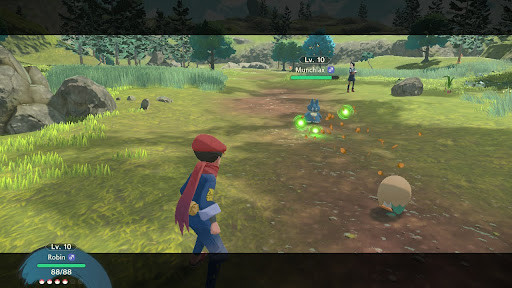 In fact, that gameplay is where Arceus stood out, even among other Pokémon games. In contrast to the traditional experience, Pokémon here can be caught without engaging them in the battle. You can simply throw pokéballs at them with varying degrees of success. Sneaking and hitting a Pokémon from behind can increase the chances of it getting caught. In addition to pokéballs, you can also throw food to distract Pokémon, stun them with spoiled apricorns or throw a ball containing Pokémon if a battle has to happen. While battling isn’t as much of a focus this time around, it’s still necessary in order to catch certain Pokémon and complete research tasks. Research tasks are sets of milestones that go toward unlocking Pokédex entries, as this time it's not as simple as just catching Pokémon. These tasks range from giving Pokémon food, to seeing them use certain moves, to completing specific sidequests. It’s a more engaging way of filling the Pokédex and an appropriate one considering the games setting. I personally found it very enjoyable to have to do the extra leg work.
In fact, that gameplay is where Arceus stood out, even among other Pokémon games. In contrast to the traditional experience, Pokémon here can be caught without engaging them in the battle. You can simply throw pokéballs at them with varying degrees of success. Sneaking and hitting a Pokémon from behind can increase the chances of it getting caught. In addition to pokéballs, you can also throw food to distract Pokémon, stun them with spoiled apricorns or throw a ball containing Pokémon if a battle has to happen. While battling isn’t as much of a focus this time around, it’s still necessary in order to catch certain Pokémon and complete research tasks. Research tasks are sets of milestones that go toward unlocking Pokédex entries, as this time it's not as simple as just catching Pokémon. These tasks range from giving Pokémon food, to seeing them use certain moves, to completing specific sidequests. It’s a more engaging way of filling the Pokédex and an appropriate one considering the games setting. I personally found it very enjoyable to have to do the extra leg work.
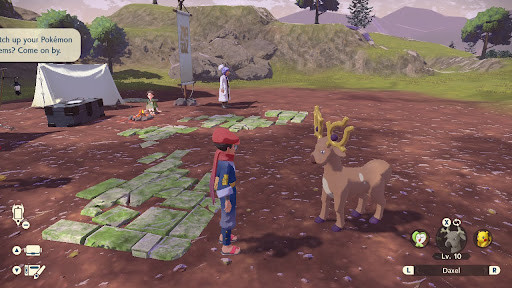 Interactions with wild Pokémon aren’t the only things to get changed up a bit. Battles themselves also feel a bit different. Fundamentally they unfold the same way, being turn based and relying on a bit of strategy with type matchups and so forth. But unlike other games, there’s a new action order system. Here, Pokémon take actions and the order is decided by their action speed, which is impacted by a number of factors, notably the Pokémon’s speed stat. This means a Pokémon could essentially move twice in a row with high enough action speed. Impacting this is the addition of mastery. If a Pokémon masters a move(either by leveling up or using a seed of mastery at the training grounds) it can use the move in either agile style or strong style. The former reduces effectiveness in exchange for letting the Pokémon move faster, while the later is the opposite, increased effectiveness with reduced speed. One small detail I want to mention is that you can actually move during battles. It lets the player escape during battles with wild Pokémon but otherwise doesn’t impact anything. I bring it up because it’s a nice touch that combined with everything else, makes battle feel more dynamic than they ever have.
Interactions with wild Pokémon aren’t the only things to get changed up a bit. Battles themselves also feel a bit different. Fundamentally they unfold the same way, being turn based and relying on a bit of strategy with type matchups and so forth. But unlike other games, there’s a new action order system. Here, Pokémon take actions and the order is decided by their action speed, which is impacted by a number of factors, notably the Pokémon’s speed stat. This means a Pokémon could essentially move twice in a row with high enough action speed. Impacting this is the addition of mastery. If a Pokémon masters a move(either by leveling up or using a seed of mastery at the training grounds) it can use the move in either agile style or strong style. The former reduces effectiveness in exchange for letting the Pokémon move faster, while the later is the opposite, increased effectiveness with reduced speed. One small detail I want to mention is that you can actually move during battles. It lets the player escape during battles with wild Pokémon but otherwise doesn’t impact anything. I bring it up because it’s a nice touch that combined with everything else, makes battle feel more dynamic than they ever have. 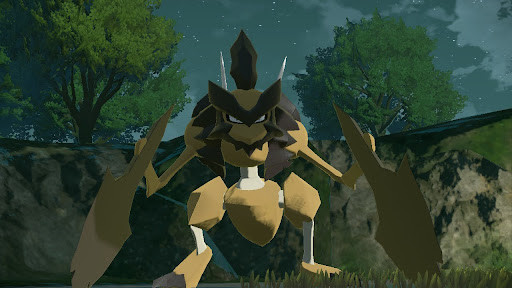 Speaking of the Pokémon, Game Freak did an excellent job making them feel like living creatures here. They have their own patterns and behaviors which influence how you approach catching them. Sometimes I would find myself waiting to see if a Pokemon would fall asleep or pay attention to where it was and where it was going so I could avoid it if I needed to. It’s a neat little detail and works well with the fact that every Pokemon shows up in the overworld. Besides appearing in the overworld, Pokemon can also show up in mass outbreaks. Mass outbreaks see Pokemon swarm around and can be tracked on the in game map. Following the Daybreak update which was released post launch, new massive mass outbreaks can appear in the post-game which feature rare and otherwise hard to find Pokemon. All this on top of Alphas(Powerful, evolved Pokemon that attack the player on sight) and Space-Time Distortions which are home to rare items and Pokemon that can’t be found anywhere else.
Speaking of the Pokémon, Game Freak did an excellent job making them feel like living creatures here. They have their own patterns and behaviors which influence how you approach catching them. Sometimes I would find myself waiting to see if a Pokemon would fall asleep or pay attention to where it was and where it was going so I could avoid it if I needed to. It’s a neat little detail and works well with the fact that every Pokemon shows up in the overworld. Besides appearing in the overworld, Pokemon can also show up in mass outbreaks. Mass outbreaks see Pokemon swarm around and can be tracked on the in game map. Following the Daybreak update which was released post launch, new massive mass outbreaks can appear in the post-game which feature rare and otherwise hard to find Pokemon. All this on top of Alphas(Powerful, evolved Pokemon that attack the player on sight) and Space-Time Distortions which are home to rare items and Pokemon that can’t be found anywhere else. 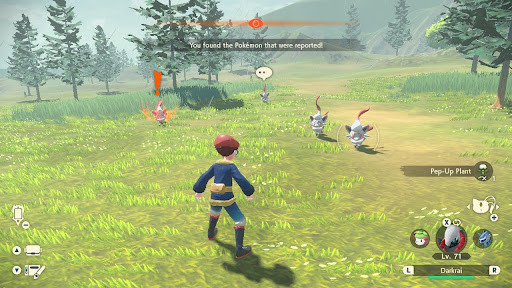 This brings me to the visuals. One thing I’ve noticed is that every Pokémon game has its own distinctive style, even after transitioning to 3D more than a decade ago. Arceus is no different. Rather than the chibi style of the Diamond and Pearl remakes or the cel shaded glossy look of Sword and Shield, Legends: Arceus opts for a more painted kind of aesthetic. From the sky, to the horizon and the ever looming Mt Coronet, everything in the game has a hand drawn look to it that’s quite striking. In addition to the Jubilife Village hub area, there’s also 5 distinctive biomes for players to explore that become accessible as the game progresses. Each of these comes with their own types of terrain and native Pokémon as well their own challenges. From the plains of the Obsidian Fieldlands, to the sparkling ocean of the Cobalt Coastlands and the frigid wastes of the Alabaster Icelands, there’s a good amount of visual variety to enjoy. I’d also say this game has some of the best looking character models for both Pokemon and npcs. I never got tired of looking at either and being amazed. The game looks wonderful and the nods to classic characters and sights from the original Sinnoh games never failed to bring a smile to my face. Accompanying all of this is a lovely soundtrack full of remixes of classic Diamond and Pearl themes. I enjoy the tranquility of Jubilife Village and how it distinguishes itself from the hustle and bustle of its modern city counterpart. I love that the battle theme for the various leaders of the Diamond and Pearl clans is a remix of the Diamond and Pearl Gym Leader theme. There are more examples of this but I’ll let you discover them for yourself. Other than that, the Pokemon cries sound as good as ever and the ambient music for the different biomes suits them well. The game is a treat for the ears as much as it is for the eyes.
This brings me to the visuals. One thing I’ve noticed is that every Pokémon game has its own distinctive style, even after transitioning to 3D more than a decade ago. Arceus is no different. Rather than the chibi style of the Diamond and Pearl remakes or the cel shaded glossy look of Sword and Shield, Legends: Arceus opts for a more painted kind of aesthetic. From the sky, to the horizon and the ever looming Mt Coronet, everything in the game has a hand drawn look to it that’s quite striking. In addition to the Jubilife Village hub area, there’s also 5 distinctive biomes for players to explore that become accessible as the game progresses. Each of these comes with their own types of terrain and native Pokémon as well their own challenges. From the plains of the Obsidian Fieldlands, to the sparkling ocean of the Cobalt Coastlands and the frigid wastes of the Alabaster Icelands, there’s a good amount of visual variety to enjoy. I’d also say this game has some of the best looking character models for both Pokemon and npcs. I never got tired of looking at either and being amazed. The game looks wonderful and the nods to classic characters and sights from the original Sinnoh games never failed to bring a smile to my face. Accompanying all of this is a lovely soundtrack full of remixes of classic Diamond and Pearl themes. I enjoy the tranquility of Jubilife Village and how it distinguishes itself from the hustle and bustle of its modern city counterpart. I love that the battle theme for the various leaders of the Diamond and Pearl clans is a remix of the Diamond and Pearl Gym Leader theme. There are more examples of this but I’ll let you discover them for yourself. Other than that, the Pokemon cries sound as good as ever and the ambient music for the different biomes suits them well. The game is a treat for the ears as much as it is for the eyes. 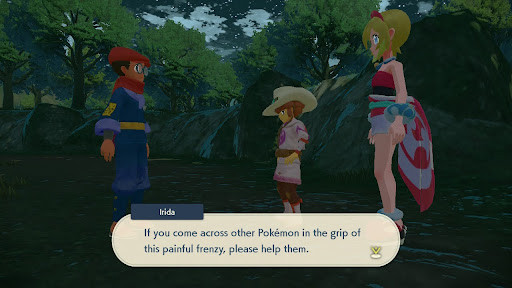
Is Legends: Arceus the greatest Pokémon game ever? Very debatable and not a question I can readily answer. What I can say is that Legends: Arceus is very much worth the price of admission. The game has an interesting story, interesting characters and expands upon the lore in ways that other games don’t. The open world mechanics bridge the gap between the wild areas of Sword and Shield and the fully explorable overworld of Scarlet and Violet. It’s easy to see the journey Game Freak took which would lead us to Paldea. And Legends: Arceus was such a breath of fresh air that fans clamored for another entry under the Legends umbrella. Sure enough, that wish came true. Whether that next entry is a grand step forward, or an unfortunate step back is a question for another time. Regardless, Arceus’ legacy remains strong and with good reason. What happened in Hisui in the distant past, continues to shape the future even now.
